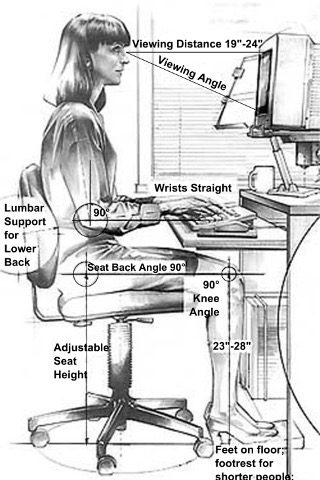Remote Working: Correct Office Ergonomics.

Remote Working: The Employee’s Perspective
13/08/2020
Remote Working: Positive Mental Health.
13/08/2020Correct ergonomics are critically important to the wellbeing and productivity of staff. Here are some very useful guidelines.
Ergonomics
The concept and principles of Ergonomics
The concept of ergonomics can be describe as the study of the tasks, equipment and the environment people have to work or live in, taking into account their abilities and limitations. The main objective is to ensure any of these do not any a negative impact on a person’s health, safety and welfare. How a person holds their posture, carries out the task in a particular environment is analysed and considered when developing work tasks, workplace design, policies and procedures.
Ergonomic principles have been developed to assist employers and other businesses to ensure their employees, customers and users will not suffer any problems relating to their physical and mental health as a result of using a product, service or carrying out a work task provided by them.
An employee must be provided a safe place of work, in a safe environment and carry out their job which will have little or zero impact on their wellbeing.
In general, under the Safety, Health and Welfare at Work Act 2005, it specifies that a health and safety risk assessment is carried out in the work place to identify the hazards and the potential risks associated with these hazards. Its aim is to ensure the safety of its employees, customers and visitors.
The below principles of ergonomics are applied during the assessment.
- The person must be able to apply all the safe manual handling techniques while carrying out all their duties
- If the task is repetitive, its impact should not have any musculoskeletal defect orRepetitive Strain Injuries” (RSIs) on a person.
- Appropriate temperature and lighting must be applied where possible
Workplace Design
As ergonomics is about improving working conditions while ensuring tasked are completed safely. It also looks at productivity of the worker. Providing more efficient machinery, tools and environment including location and design of all of these are in aid of increasing output and notably reducing costs for the business. Implementing the latest technology and using up to date data on ergonomics can have a sufficient impact not only on task efficiency but also on the personnel development and job satisfaction of an employee. In total, the design of a premises must consider the safety, health and welfare of its employees, customers and visitors.
Unfavourable Ergonomics conditions
The characteristic of an unfavourable ergonomic condition can be defined as “when a person is carrying, lifting, putting down, pulling or pushing a load or indeed tying at a computer, that could result in a physical strain on their body, with the potential to cause a musculoskeletal injury in particular to their wrists and back“. Other environmental conditions such as air quality and abnormal temperatures can result in headaches and tiredness and/or excessive noise result in hearing loss.
Solutions to risk reduction
Under the Safety, Health and Welfare Act 2005 it clearly states that an employer must take all reasonable measures to ensure its safety and welfare of employees. Employees must also take all steps necessary to ensure their own health and safety at work.
Any person in the health profession would say listen to your body and watch out for signs that may cause mental or physical ill health.
So it is fair to say if a person is suffering from any physical pain, stress, fatigue, headaches etc. due to their work task or environment, it must be communicated the employer.
A Health & Safety risk assessment must be carried out by a trained person who has the appropriate knowledge of the guidelines of risk reduction and how to implement the corrective actions.
Task procedures must incorporate the ergonomic principles that contribute to risk reduction
Employers, where possible should introduce mechanical aids or equipment to avoid the need for manual handling.
(Image taken from, Human factors and ergonomics – Wikipedia.)
Contact Us Today
To make an enquiry about a Remote Work Solution for your staff contact us today:
James Hackett Email: james@soundav.ie Mobile: 087 256 8802
Martin Cullinan Email: martin@soundav.ie Mobile: 087-255 6829




